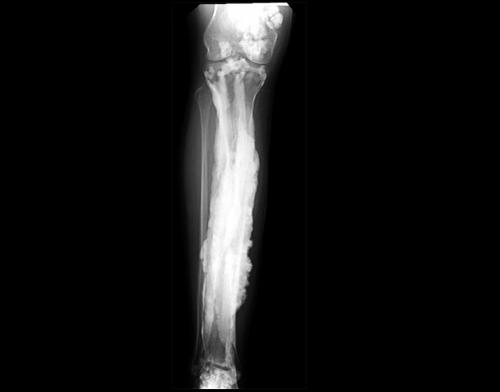NIH researchers crack mystery behind rare bone disorder
Study finds gene mutations that cause “dripping candle wax” bone disease.
Researchers at the National Institutes of Health worked with 15 patients from around the world to uncover a genetic basis of “dripping candle wax” bone disease. The rare disorder, known as melorheostosis, causes excess bone formation that resembles dripping candle wax on x-rays. The results, appearing in Nature Communications, offer potential treatment targets for this rare disease, provide important clues about bone development, and may lead to insights about fracture healing and osteoporosis.

An x-ray image of a patient with melorheostosis shows excess bone formation, likened to dripping candle wax.
Though there are only about 400 known cases of this disorder worldwide, 15 unrelated adults with the condition from around the globe volunteered to come to the NIH Clinical Center to undergo biopsies of both affected and unaffected bones. The condition causes pain and bone deformity, which can limit the function of bones.
“Scientists previously assumed that the genetic mutations responsible for melorheostosis occurred in all cells of a person with the disorder,” said co-senior author Timothy Bhattacharyya, M.D., head of the Clinical and Investigative Orthopaedics Surgery Unit at the National Institute on Arthritis and Musculoskeletal and Skin Diseases (NIAMS) at NIH. “Our team hypothesized that mutations might only occur in the affected bone tissue.”
Researchers compared samples of healthy and affected bone from each participant to look for differences in the exome, the portion of the genome that codes for proteins. Comparing genetic information from both samples in each patient allowed the team to pinpoint even low levels of the mutations. Experts from NIAMS and the Eunice Kennedy Shriver National Institute of Child Health and Human Development (NICHD) worked together on this study.
The analysis revealed that 8 of the 15 participants had mutations in the MAP2K1 gene in the affected bone only. MAP2K1 produces the protein MEK1. The gene MAP2K1 has previously been linked to some types of cancerous growths as well as to conditions that lead to abnormal blood vessel formation in the head, face or neck.
In melorheostosis, all the identified MAP2K1 mutations affect a region of the MEK1 protein that normally suppresses its activity, thus they cause MEK1 to become overactive. The bone growth is considered benign and does not spread to other parts of the body.
“This is an exciting study of a very rare bone disorder that not only identified the responsible mutation in half of the patients, but uncovered fundamental information about the role of a cancer-related gene in the metabolic pathways of normal bone,” said study co-senior author Joan Marini, Ph.D., M.D., of NICHD. “When we started, we had no preconceived causative pathways, but the participation of the patients has really changed the scientific landscape on this topic. Further studies on how this pathway works in both normal and mutant bone cells may have broad implications that could benefit a wider population.”
“Most adults have the problem of weakening bones as they grow older. These patients have the opposite problem as some of their bones are rock hard and still growing,” said Bhattacharyya. “The prospect that we could somehow harness this pathway in the future is so exciting.”
Source: U.S. National Institutes of Health
- 340 reads
Human Rights
Ringing FOWPAL’s Peace Bell for the World:Nobel Peace Prize Laureates’ Visions and Actions

Protecting the World’s Cultural Diversity for a Sustainable Future

The Peace Bell Resonates at the 27th Eurasian Economic Summit

Declaration of World Day of the Power of Hope Endorsed by People in 158 Nations

Puppet Show I International Friendship Day 2020

